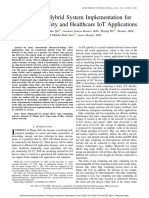Design and Implementation of SMQTT For Iot Applications: Abstract
Design and Implementation of SMQTT For Iot Applications: Abstract
Uploaded by
Shanaya chauhanCopyright:
Available Formats
Design and Implementation of SMQTT For Iot Applications: Abstract
Design and Implementation of SMQTT For Iot Applications: Abstract
Uploaded by
Shanaya chauhanOriginal Title
Copyright
Available Formats
Share this document
Did you find this document useful?
Is this content inappropriate?
Copyright:
Available Formats
Design and Implementation of SMQTT For Iot Applications: Abstract
Design and Implementation of SMQTT For Iot Applications: Abstract
Uploaded by
Shanaya chauhanCopyright:
Available Formats
Dhanshri Kolhe et. al.
/ International Journal of New Technologies in Science and Engineering
Vol. 5 , Issue. 3, 2018, ISSN 2349-0780
Design and Implementation of SMQTT for IoT
Applications
Dhanshri Kolhe Prof. Smita Kapse
dhanshrikolhe5@gmail.com kawadesmita@gmail.com
Department of computer science Department of computer science
Yeshwantrao Chavan College of Engineering, Yeshwantrao Chavan College of Engineering,
Nagpur Nagpur
Abstract: heterogeneity of devices, device identity, device
management, secure device to device communication
In the IoT world, establishing a strong mobile network (D2D), etc. To enable the integration and management
architecture will be critical for organizations to bring of heterogeneous IoT devices, architectures such as
together people, processes, data and things. Among Ubiquitous Sensor Network (USN), Sensor Web
the various available protocols and standards to Enablement (SWE), etc., are proposed. Here, security
network IoT entities, the Message Queue Telemetric of devices (such as identity theft, data integrity), D2D
Transport (MQTT) is already a reference solution. It communication, etc., are not addressed rigorously.
provides a publish/subscribe messaging transport Further most of the privacy and security features
specifically designed to be used in devices with limited proposed by them are at a nascent level. To address
resources over constrained networks. A message this cryptography techniques based on Public Key
broker is an imperative component in IoT systems, and Infrastructure (PKI), Identity based encryption (IBE),
it works as a gateway between IoT devices and etc., are proposed for secure IoT communication.
application platforms. With the growth of IoT devices Though current techniques serve the purpose of basic
today, these systems can easily overwhelm message security primitives for D2D communications, they do
brokers unless the software can fully utilize hardware not address at the protocol level. Communication
resources such as multi-core facility. In this paper protocols exists such as Constrained Application
proposed system is designed to Implement the SMQTT Protocol (CoAP, UDP based), Message Queue
protocol for secure data transfer between entities. Telemetry Transport (MQTT, TCP based), MQTT-SN
Using IomaTic as a development platform system (UDP based), etc. which are deployed for IoT at
demonstrate the proof of concept and its different layers have limited or devoid of security
implementation. features. Hence these protocols need to address
security issues for IoT.
Keywords: MQTT, D2D, IoT, Cryptography,
IomaTic Moreover, MQTT and MQTT-SN are more
prevalent than CoAP and find applications in the area
of social networks, Vehicle to Vehicle communication
I. INTRODUCTION (V2V) and sensor networks. Hence in proposed work
MQTT and MQTT-SN for IoT w.r.t security. Note that
Innovations in digital things, Information it is the user’s responsibility to address security issues
Communication Technology and IPV6 (Internet for MQTT and MQTT-SN.
protocol) are enabling rapid deployment of Internet of
Things (IoT) around the globe. It is estimated that In this direction, it is suggested to enable
trillions of IoT devices are going to be deployed in security forMQTT by envisaging SSL/TLS with
next five years. IoT Applications are immense in certificates and session key management. However,
number and utilized to provide solutions for multitude for IoT due to multitude of heterogeneous devices,
of diversified problems. Though IoT has lot of storing and managing the certificates and key
potentials in the digital world, during its deployment, exchanges for every session is cumbersome and also
it encounters several issues with respect to (w.r.t)
Available online @ www.ijntse.com 47
Dhanshri Kolhe et. al. / International Journal of New Technologies in Science and Engineering
Vol. 5 , Issue. 3, 2018, ISSN 2349-0780
SSL/TLS suffers from attacks such as BEAST, Proposed system is also to adopt new advancing
CRIME, RC4, Heartbleed, etc. Thus, a scalable, technology, “Lightweight Cryptography”, in the IoT.
lightweight and robust security mechanism is required System describes two reasons that support this
for MQTT and its variants for deploying in IoT. proposal. In order to achieve end-to-end security, end
nodes have an implementation of a symmetric key
Hence in this direction, we propose a Secure algorithm. For the low resource-devices, e.g. battery-
MQTT (SMQTT) which augments security feature for powered devices, the cryptographic operation with a
the existing MQTT protocol and its variants based on limited amount of energy consumption is important.
lightweight Attribute Based Encryption (ABE) over Application of the lightweight symmetric key
elliptic curves. The advantage of using ABE is because algorithm allows lower energy consumption for end
of its inherent design which supports broadcast devices.
encryption (with one encryption, message is delivered The footprint of the lightweight cryptographic
to multiple intended users) and thus suitable for IoT primitives is smaller than the conventional
applications. ABE are of two types: (i). Ciphertext cryptographic ones. The lightweight cryptographic
Policy based ABE (CP-ABE) and (ii). Key Policy primitives would open possibilities of more network
based ABE (KPABE). In general, each of these connections with lower resource devices. A
schemes are different w.r.t the access policy, key comparison of the lightweight properties with the
management and are suitable for different kinds of conventional cryptographic primitives is shown in
applications. Thus as part of our study, we analyse Appendix. The comparison in Appendix focuses on
suitability of these schemes for SMQTT from IoT hardware properties. Some end nodes might be able to
perspective. To the best of our knowledge, we have embed general-purpose micro-processors and software
not seen any security requirements and solutions of properties are considered important in such platforms.
secure MQTT for heterogeneous IoT devices. The However, lowest cost devices can embed only
proposed security feature is efficient, robust and application-specific ICs due to limited cost and power
scalable. consumption, where hardware properties are crucially
important.
II. PROBLEM STATEMENT
III. METHODOLOGY
The main objective of proposed work is to
develop a mechanism that allows the system to Proposed system has been designed by keeping
transfer information between multiple IoT devices temperature sensor monitoring and remote home
or between device to server in secure way using appliances control over TCP/IP network. System
modified version of MQTT protocol called secure has been designed in three different modules.
MQTT. Below points describes the different
objective considerations. 3.1 Client / Publisher Hardware:
A IomaTic Development board-based
• To deploy a MQTT server and create a web implementation which use ESP8266 as a wi-fi
communication between IoT board server. communication module, DHT11 as a temperature
• To develop a MQTT protocol in embedded monitoring system, relay switching unit for
environment for rapid communication. appliances tripping, LCD screen for information
• Design an application to monitor and control monitoring and finally Atmega328P as a
the things through MQTT protocol. microcontroller for logic processing. This part
• Modifying the communication by securing the connects to broker as a client and send
MQTT communication using encryption temperature information to server secondly it
methods. accepts from server to operation appliances
connected to the relay unit. It also utilizes the
Available online @ www.ijntse.com 48
Dhanshri Kolhe et. al. / International Journal of New Technologies in Science and Engineering
Vol. 5 , Issue. 3, 2018, ISSN 2349-0780
encryption algorithms to securely transmit the It takes the ease of Arduino programming IDE
messages. and the power of open source Arduino Uno board,
clubbed together with tons of on-board
3.2 Broker / Server: component and modules makes it perfect solution
for the beginners who are willing to learn IoT and
This is a TCP/IP based MQTT broker or server
the experts who are ready to deploy IoT as
which is responsible to accept network connection
applications or product.
request from publisher and subscriber. This will
transmit messages between connected client either
as a publisher or the subscriber. It mainly works
as a post master between subscriber and publisher.
3.3 Client / Subscriber:
A client program which connect to server and
subscribe itself to receive temperature in
formation and graphically display it to user. It also
allows user to control connected appliances using
graphical user interface. Fig. 3.1 IomaTic Development Board
Unique Arduino and Atmega328p based
development board having on-board components
like SIM 808 with SIM slot, GPS, Bluetooth,
et
Server / Broker ESP8266, DHT11, buzzer, 16x2 and 16x4 LCD
TC
ck
So
support, 30amp. Relay, serial interface, mini USB
P/
IP
IP
P/
So
TC
ck
programming port, connectors for different
et
configurable IOs, multilevel voltage out like 12v,
5v, 3.3v so you can connect any sensor directly to
Secure Messenging
board, configuration DIP switches to control
Client / Subscriber Client / Publisher
Enc / Dec
components or modules power state and LED
Enc / Dec
indications for different modules. To control these
Fig. 3.0 Proposed architecture entire modules and to develop IoT applications,
IomaTic board comes up with different sample
Fig. 3.0 describes the overall system architecture codes and almost 40+ ready to deploy application
of the implementation. MQTT is mainly used for where at single click IomaTic board can be
unidirectional communication that is to publish converted in to real life applications that to free of
the information to multiple channels at a time cost.
over TCP/IP Communication. In proposed system IV. IMPLEMENTATION
bidirectional Communication is established over
TCP/IP socket connection in order to fetch the
topic information and send the control command
to the hardware or publisher.
Proposed system implemented over
IomaTic where, IomaTic is first of its kind,
complete IoT application development platform.
Available online @ www.ijntse.com 49
Dhanshri Kolhe et. al. / International Journal of New Technologies in Science and Engineering
Vol. 5 , Issue. 3, 2018, ISSN 2349-0780
communication and execution result between all
entities in proposed system. Subscriber show the
received information form hardware, hardware
publisher shows the temperature information and
control the devices and finally server shows
overall information exchange and packet detail.
V. CONCLUSION
Since MQTT, the lightweight messaging
publish/subscribe protocol can be used to share
any dynamic data, the sharing of data, e.g., flood
Fig 4.1 (A) Subscriber monitoring data, earthquake data, or traffic data
via MQTT protocol, can be used to improve the
way of human life. However, there are variety of
topic naming when the publishers shared their
data over the MQTT protocol. To create the
standard of topic naming MTNC was proposed in
our previous work. In this work we implement the
secure MQTT and tested it over wi-fi network
using IomaTic development platform. With the
help of socket programming in TCP/IP mode
system generates the result as expected
References:
Fig. 4.2 (B) Hardware [1] B. S. Adiga, P. Balamuralidhar, M. A. Rajan, R. Shastry,
and V. L.Shivraj, “An Identity Based weEncryption Using
Elliptic Curve Cryptography for Secure M2M
Communication,” in Proceedings of the First International
Conference on Security of Internet of Things, ser.
SecurIT’12. ACM, 2012, pp. 68–74.
[2] D. D´ıaz Pardo de Vera, A´ . Sigu¨enza Izquierdo, J.
Bernat Vercher, andL. A. Hern´andez G´omez, “A
Ubiquitous sensor network platform for integrating smart
devices into the semantic sensor web,” vol. 14, no. 6.
Multidisciplinary Digital Publishing Institute, 2014, pp. 10
725–10 752.
[3] X. Wang, J. Zhang, E. Schooler, and M. Ion,
“Performance evaluationof Attribute-Based Encryption:
Toward data privacy in the IoT,” in Communications (ICC),
2014 IEEE International Conference on, June 2014, pp.
Fig. 4.3 (C) Server /Broker 725–730.
Fig. 4.1 (A), (B), (C) shows the real time
Available online @ www.ijntse.com 50
Dhanshri Kolhe et. al. / International Journal of New Technologies in Science and Engineering
Vol. 5 , Issue. 3, 2018, ISSN 2349-0780
[4] M. Ion, “Security of Publish/Subscribe Systems,” Ph.D. [14] R. Ostrovsky, A. Sahai, and B. Waters, “Attribute-
dissertation, University of Trento, Italy, May 2013. based Encryption with Non-monotonic Access Structures,”
in Proceedings of the 14th ACM Conference on Computer
[5] D. Locke, “MQ Telemetry Transport (MQTT) and Communications Security, ser. CCS ’07, 2007, pp. 195–
V3.1Protocol\Specification,”http://www.ibm.com/developer 203.
works/library/ws-mqtt/, 2010.
[6] Davis, Ernesto Garc´ıa and Calveras, Anna and [15] A. Stanford-Clark and H. L. Truong, “MQTT For
Demirkol, Ilker, “Improving packet delivery performance of Sensor Networks (MQTT-SN) Protocol
publish/subscribe protocols in wireless sensor networks,” Specification,”http://mqtt.org/documentation, 2013.
vol. 13, no. 1. Multidisciplinary Digit Publishing Institute,
2013, pp. 648–680. [16] Zaidi, Syed Ali Raza, et al. "Enabling IoT empowered
smart lighting solutions: A communication theoretic
[7] V. Goyal, O. Pandey, A. Sahai, and B. Waters, perspective." Wireless Communications and Networking
“Attribute-based Encryption for Fine-grained Access Conference Workshops (WCNCW), 2014 IEEE. IEEE,
Control of Encrypted Data,” in Proceedings of the 13th 2014.
ACM Conference on Computer and Communications
Security, ser. CCS ’06, 2006, pp. 89–98. [17] Zhang, Yuejun, Ping Zhou, and Mingguang Wu.
"Research on DALI and Development of Master-Slave
[8] J. Bethencourt, A. Sahai, and B. Waters, “Ciphertext- module." 2006 IEEE International Conference on
Policy Attribute- Based Encryption,” in Proceedings of the Networking, Sensing and Control. IEEE, 2006.
2007 IEEE Symposium on Security and Privacy, ser. SP
’07, Washington, DC, USA, 2007, pp. 321–334. [18] Alkar, Ali Ziya, and UmitBuhur. "An Internet based
wireless homeautomation system for multifunctional
[9] P. Pal, G. Lauer, J. Khoury, N. Hoff, and J. Loyall,
“P3S: A Privacy Preserving Publish-subscribe Middleware,” devices." IEEE Transactions on Consumer Electronics 51.4
in Proceedings of the 13thInternational Middleware
(2005): 1169-1174.
Conference, ser. Middleware ’12, pp. 476–495.
[19] Kovatsch, Matthias, Markus Weiss, and Dominique
[10] M. Ion, G. Russello, and B. Crispo, “Supporting
Publication and Subscription Confidentiality in Pub/Sub Guinard. "Embedding internet technology for home
Networks,” in Security and Privacy in Communication
automation." Emerging Technologies and Factory
Networks, ser. Lecture Notes of the Institute for Computer
Sciences, Social Informatics and Telecommunications Automation (ETFA), 2010 IEEE Conference on. IEEE,
Engineering, vol. 50, 2010, pp. 272–289.
2010.
[11] M. A. Tariq, “Non-functional Requirements in
Publish/Subscribe Systems,”Ph.D. dissertation, Universit¨at
[20] Zaheeruddin and Munish Manas, “A New Approach for
Stuttgart, Fakult¨at Informatik, Elektrotechnik und
Informationstechnik, Germany, August 2013. the Design and Development of Renewable Energy
Management System through Microgrid Central
[12] A. Sahai and B. Waters, “Fuzzy Identity-based
Encryption,” in Proceedings of the 24th Annual Controller”, Energy Reports, vgt5Elsevier Inc., vol. 1, pp.
International Conference on Theory and Applications of
156-163, 2015.
Cryptographic Techniques, ser. EUROCRYPT’05, Berlin,
Heidelberg, 2005, pp. 457–473.
[13] B. S. Adiga, M. A. Rajan, R. Shastry, V. L. Shivraj,
and P. Balamuralidhar,“Lightweight IBE scheme for
Wireless Sensor nodes,”in Advanced Networks and
Telecommuncations Systems (ANTS), 2013 IEEE
International Conference on, Dec 2013, pp. 1–6.
Available online @ www.ijntse.com 51
You might also like
- The Voice of The MountainDocument7 pagesThe Voice of The MountainHimank Saklecha80% (5)
- Olympus - Clean BF 160Document1 pageOlympus - Clean BF 160Eduardo ArreguinNo ratings yet
- Guns Germs and SteelDocument4 pagesGuns Germs and Steelapi-247486691No ratings yet
- Challenges Facing On IoT and Gaps That Exist in The IoT Cybersecurity of Data Transferred by MQTT & CoAP ProtocolsDocument8 pagesChallenges Facing On IoT and Gaps That Exist in The IoT Cybersecurity of Data Transferred by MQTT & CoAP ProtocolsInternational Journal of Innovative Science and Research Technology100% (1)
- Mqtt Iscc2017 CrDocument8 pagesMqtt Iscc2017 CrcarolinatelucciNo ratings yet
- A Novel Hybrid Authentication Protocol Utilizing Lattice-Based Cryptography For IoT Devices in Fog NetworksDocument18 pagesA Novel Hybrid Authentication Protocol Utilizing Lattice-Based Cryptography For IoT Devices in Fog NetworksMisbaah NazNo ratings yet
- Post_Quantum_Blockchain_Security_for_the_Internet_Document27 pagesPost_Quantum_Blockchain_Security_for_the_Internet_Soft PatagoniaNo ratings yet
- Securing The Internet of Things: A Standardization PerspectiveDocument11 pagesSecuring The Internet of Things: A Standardization PerspectiveTeddy IswahyudiNo ratings yet
- Air Ehr Our 2016Document6 pagesAir Ehr Our 2016ozkdNo ratings yet
- Post-Quantum Lattice-Based Secure Reconciliation Enabled Key Agreement Protocol For IoTDocument13 pagesPost-Quantum Lattice-Based Secure Reconciliation Enabled Key Agreement Protocol For IoT2K20CO158 Eshan DevNo ratings yet
- Midterm Exam Review Questions 1 - NewDocument21 pagesMidterm Exam Review Questions 1 - NewSirus DanhNo ratings yet
- Post Quantum Blockchain Security for the Internet of Things Survey and Research DirectionsDocument28 pagesPost Quantum Blockchain Security for the Internet of Things Survey and Research Directionsrishabh.qc991No ratings yet
- Securing Iot With BlockchainDocument4 pagesSecuring Iot With BlockchainNguyễn HuyNo ratings yet
- Smart Home Automation Based On Iot Using Arduino Mega: Abstract-In The Advancement of TechnologiesDocument4 pagesSmart Home Automation Based On Iot Using Arduino Mega: Abstract-In The Advancement of TechnologiesUdupiSri groupNo ratings yet
- ملخص الكتابDocument26 pagesملخص الكتابaboodahmedfatahNo ratings yet
- SDN Framework For Securing Iot Networks: AbstractDocument14 pagesSDN Framework For Securing Iot Networks: AbstractGuillo YeroviNo ratings yet
- TNN-IDS - Transformer Neural Network-Based Intrusion Detection System ForDocument11 pagesTNN-IDS - Transformer Neural Network-Based Intrusion Detection System ForFaraz Ali ArainNo ratings yet
- Novel Technique For Securing IoT Systems by Using Multiple ECC and Ceaser Cipher CryptographyDocument8 pagesNovel Technique For Securing IoT Systems by Using Multiple ECC and Ceaser Cipher CryptographyBossNateNo ratings yet
- MQTT Protocol For Industry AutomationDocument13 pagesMQTT Protocol For Industry AutomationVariNo ratings yet
- Secure Iot Devices Using Aes Encryption: K. Siva Kumar Swamy, G.Sony, CH - Jagadeesh Ram, B.Navven, J.HarshithaDocument4 pagesSecure Iot Devices Using Aes Encryption: K. Siva Kumar Swamy, G.Sony, CH - Jagadeesh Ram, B.Navven, J.HarshithaNissy Rose SenaNo ratings yet
- F11410486S419Document4 pagesF11410486S419Syed Tarooq AfnanNo ratings yet
- MQTT WorkDocument9 pagesMQTT WorkMuhammad syifa Sy1f4No ratings yet
- impDocument14 pagesimpsahillanjewar294No ratings yet
- An Efficient IoT Group Association and Data Sharing - 2023 - Cyber Security andDocument6 pagesAn Efficient IoT Group Association and Data Sharing - 2023 - Cyber Security andRoxana StanNo ratings yet
- Iot NotesDocument5 pagesIot NotesUdhaya KumarNo ratings yet
- IOT SecurityDocument15 pagesIOT SecurityabdulNo ratings yet
- (IJCST-V12I2P2) :K Pushpalatha, DR R KalaiarasiDocument12 pages(IJCST-V12I2P2) :K Pushpalatha, DR R Kalaiarasieditor1ijcstNo ratings yet
- Setting Up A Multi-Purpose Internet of Things SystemDocument4 pagesSetting Up A Multi-Purpose Internet of Things SystemtHe lOsErNo ratings yet
- Papers On Security Issues in IotDocument6 pagesPapers On Security Issues in IotRISHIT ANAND 20BCE2146No ratings yet
- Granjal 2015Document19 pagesGranjal 2015Hannan SatopayNo ratings yet
- Keeping The Smart & Secure: Assessing The Security, Analytics & Overall Ecosystem of Smart GatewaysDocument12 pagesKeeping The Smart & Secure: Assessing The Security, Analytics & Overall Ecosystem of Smart GatewaysKang HsiehNo ratings yet
- Secure Authentication Protocol For 5G Enabled Iot NetworkDocument6 pagesSecure Authentication Protocol For 5G Enabled Iot NetworkOsama AdlyNo ratings yet
- Quantum-Resistant Cryptography For The Internet of Things Based On Location-Based LatticesDocument19 pagesQuantum-Resistant Cryptography For The Internet of Things Based On Location-Based Lattices2K20CO158 Eshan DevNo ratings yet
- Pramod Pre Thesis Base PaperDocument10 pagesPramod Pre Thesis Base PaperPramod YadavNo ratings yet
- IOT notesDocument78 pagesIOT notesbhavanid07092002No ratings yet
- 2015 - Survey On Secure Communication Protocols For The Internet of ThingsDocument15 pages2015 - Survey On Secure Communication Protocols For The Internet of ThingsAnkit SoniNo ratings yet
- IoT-Flock An Open-Source Framework For IoT TrafficDocument6 pagesIoT-Flock An Open-Source Framework For IoT TrafficGUIDO IANNONENo ratings yet
- Blockchain-Based Access Control Techniques For IoT ApplicationsDocument29 pagesBlockchain-Based Access Control Techniques For IoT ApplicationsTimothyNo ratings yet
- Overview of Security in Internet of Things: Adeeba KhanDocument9 pagesOverview of Security in Internet of Things: Adeeba KhanAdeeba KhanNo ratings yet
- (Soutik Dey Iot)Document7 pages(Soutik Dey Iot)Soutik DeyNo ratings yet
- Time Synchronization Is A Critical Issue For OperaDocument4 pagesTime Synchronization Is A Critical Issue For OperaANJALI SNo ratings yet
- An Efficient Security Model For Industrial Internet of ThingsDocument12 pagesAn Efficient Security Model For Industrial Internet of ThingsFaraz Ali ArainNo ratings yet
- Iot Ut - 2Document20 pagesIot Ut - 2Name SurnameNo ratings yet
- High-Performance and Area-Efficient VLSI ArchitDocument6 pagesHigh-Performance and Area-Efficient VLSI ArchitgestNo ratings yet
- Reportiot NEW 1Document41 pagesReportiot NEW 1FakeNo ratings yet
- 1570535236Document6 pages1570535236siriustipsNo ratings yet
- JSS Academy of Technical EducationDocument8 pagesJSS Academy of Technical EducationPujit GangadharNo ratings yet
- N IOT - Module 1Document49 pagesN IOT - Module 1BasithNo ratings yet
- Accepted ManuscriptDocument32 pagesAccepted Manuscriptanant_nimkar9243No ratings yet
- EIOT - UNIT IV - 2024 NewDocument34 pagesEIOT - UNIT IV - 2024 Newmadhumitha.kNo ratings yet
- A Hybrid CNN+LSTM-based Intrusion Detection System For Industrial IoT NetworksDocument13 pagesA Hybrid CNN+LSTM-based Intrusion Detection System For Industrial IoT NetworksAbdelali EL IDRISSINo ratings yet
- Iot - Unit-IDocument18 pagesIot - Unit-IMohamed SugailNo ratings yet
- Basics of Iot Networking Common Iot Terms: Iot Architecture and Protocols Unit IiDocument13 pagesBasics of Iot Networking Common Iot Terms: Iot Architecture and Protocols Unit IiMaitrayee SuleNo ratings yet
- Supervisory Control and Data Acquisition Approach in Node-RED: Application and DiscussionsDocument16 pagesSupervisory Control and Data Acquisition Approach in Node-RED: Application and DiscussionsEdwin PariNo ratings yet
- I T-N S: Policy-Based Iot Network Security Using Openflow: O Et EcDocument6 pagesI T-N S: Policy-Based Iot Network Security Using Openflow: O Et EcGuillo YeroviNo ratings yet
- Identity Based Cryptography.Document7 pagesIdentity Based Cryptography.Banana KillaNo ratings yet
- Conducted by NIELIT Jorhat EC Venue: Nielit Jorhat Ec Isbt 1 Floor, Tarajan, JorhatDocument26 pagesConducted by NIELIT Jorhat EC Venue: Nielit Jorhat Ec Isbt 1 Floor, Tarajan, JorhatTanushree KalitaNo ratings yet
- Atg 1Document11 pagesAtg 1Felipe MoraisNo ratings yet
- An Authentication Model For IoT CloudsDocument4 pagesAn Authentication Model For IoT CloudsTeddy IswahyudiNo ratings yet
- IoT Based A Smart Home Automation System Using Packet TracerDocument7 pagesIoT Based A Smart Home Automation System Using Packet TracerIJRASETPublicationsNo ratings yet
- A Novel Approach Based On Machine Learning Blockchain and Decision Process For Securing Smart GridDocument10 pagesA Novel Approach Based On Machine Learning Blockchain and Decision Process For Securing Smart Gridhernandezz fernandezNo ratings yet
- Building the Internet of Things with IPv6 and MIPv6: The Evolving World of M2M CommunicationsFrom EverandBuilding the Internet of Things with IPv6 and MIPv6: The Evolving World of M2M CommunicationsNo ratings yet
- Cis 700/002: Special Topics: Secure MQTT For Iot: Sangdon Park Cis 700/002: Security of Embs/Cps/IotDocument16 pagesCis 700/002: Special Topics: Secure MQTT For Iot: Sangdon Park Cis 700/002: Security of Embs/Cps/IotShanaya chauhanNo ratings yet
- Big Data in Iot: July 2019Document8 pagesBig Data in Iot: July 2019Shanaya chauhanNo ratings yet
- Infosys GRP PresentationDocument14 pagesInfosys GRP PresentationShanaya chauhanNo ratings yet
- Smart Agriculture Using IotDocument7 pagesSmart Agriculture Using IotShanaya chauhanNo ratings yet
- 2 4 Pillers of IotDocument15 pages2 4 Pillers of IotShanaya chauhanNo ratings yet
- Types Social EntrepreneursDocument20 pagesTypes Social EntrepreneursShreya LalNo ratings yet
- FIN 201 Chapter 11 Homework QuestionsDocument4 pagesFIN 201 Chapter 11 Homework QuestionsKyzer GardiolaNo ratings yet
- Lecture2 Chapter4 - BCD To Excess-3 Code Converter DesignDocument19 pagesLecture2 Chapter4 - BCD To Excess-3 Code Converter DesignAyesha HussainNo ratings yet
- MAGSAYSAYDocument635 pagesMAGSAYSAYroseannurakNo ratings yet
- Agrment of SaleDocument2 pagesAgrment of SaleShamiso MudyanadzoNo ratings yet
- Module No 3 Aircraft Leasing & FinanceDocument8 pagesModule No 3 Aircraft Leasing & Financeshaik akhilNo ratings yet
- Slau 367 oDocument1,021 pagesSlau 367 oshanmukh addepalliNo ratings yet
- (FREE PDF Sample) HTML5 Game Development by Example Beginner S Guide Second Edition Thomas Mak EbooksDocument49 pages(FREE PDF Sample) HTML5 Game Development by Example Beginner S Guide Second Edition Thomas Mak EbooksmpimosueheyNo ratings yet
- Ancient Indian Mathematics Part 1Document116 pagesAncient Indian Mathematics Part 1MSHYDERABAD4334No ratings yet
- Green Accounting FinalDocument23 pagesGreen Accounting Finalyesh cyberNo ratings yet
- WB20BJ3428 Tax BDocument1 pageWB20BJ3428 Tax Bzaid AhmedNo ratings yet
- Shivaji University, KolhapurDocument26 pagesShivaji University, KolhapurGourav KumarNo ratings yet
- Product Planning in Rural AreasDocument22 pagesProduct Planning in Rural AreasRitika Mehrotra100% (7)
- Fourth Year ProposalDocument16 pagesFourth Year ProposalNdagire OliverNo ratings yet
- Iim TrichyDocument6 pagesIim TrichyarunsharanNo ratings yet
- Bach Invention 04 A4Document2 pagesBach Invention 04 A4Vanja PalčekNo ratings yet
- Paging MessagesDocument51 pagesPaging MessagesFatima AjmalNo ratings yet
- British L129A1 Sharpshooter RifleDocument3 pagesBritish L129A1 Sharpshooter RiflehxntaiforredditNo ratings yet
- Math 012/ Math 012B Numerical Methods and Analysis Matlab Activity 1.1 Operators and Numerical FunctionsDocument6 pagesMath 012/ Math 012B Numerical Methods and Analysis Matlab Activity 1.1 Operators and Numerical FunctionsroseleenNo ratings yet
- Street PerformerDocument6 pagesStreet PerformerKitsu NayNo ratings yet
- A Set of Measures of Centrality Based On BetweennessDocument8 pagesA Set of Measures of Centrality Based On Betweennessbruna_fonsecaNo ratings yet
- Stop TB Program - Envisioning A Tuberculosis Free World, The Goal of TheDocument4 pagesStop TB Program - Envisioning A Tuberculosis Free World, The Goal of TheCharles Mart Rabe-Rodriguez HortilanoNo ratings yet
- Acupuncture in Modern MedicineDocument400 pagesAcupuncture in Modern Medicinepranav100% (3)
- Naked-Eye Viewing: ElongationDocument1 pageNaked-Eye Viewing: ElongationAminath MeesanNo ratings yet
- Travel Drive ExampleDocument10 pagesTravel Drive Examplep-nicoNo ratings yet
- NAIOP PresentationDocument70 pagesNAIOP PresentationChristopherJordanOrtizNo ratings yet
- School ActivityDocument13 pagesSchool ActivityShuso NoukiNo ratings yet






























































































